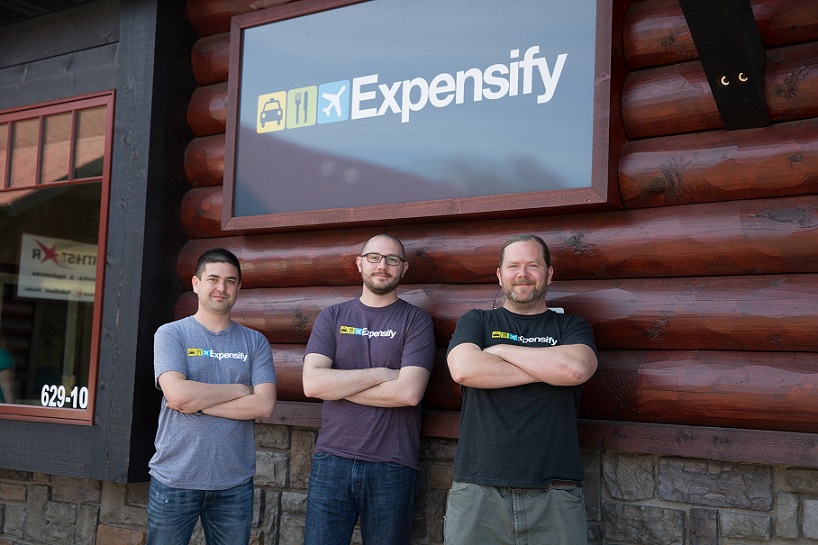Expensify may be the most ambitious software company ever to mostly abandon the Bay Area as the center of its operations.
Expensify may be the most ambitious software company ever to mostly abandon the Bay Area as the center of its operations.
The startup’s history is tied to places representative of San Francisco: The founding team worked out of Peet’s Coffee on Mission Street for a few months, then crashed at a penthouse lounge near the 4th and King Caltrain station, followed by a tiny office and then a slightly bigger one in the Flatiron building near Market Street.
Thirteen years later, Expensify still has an office a few blocks away on Kearny Street, but it’s no longer a San Francisco company or even a Silicon Valley firm. The company is truly global with employees across the world — and it did that before COVID-19 made remote working cool.
“Things got so much better when we stopped viewing ourselves as a Silicon Valley company. We basically said, no, we’re just a global company,” CEO David Barrett told TechCrunch. That globalism led to it opening a major office in — of all places —a small town in rural Michigan. That Ironwood expansion would eventually lead to a cultural makeover that would see the company broadly abandon its focus on the Bay Area, expanding from a headquarters in Portland to offices around the globe.
It makes sense that a company founded by internet pirates would let its workforce live anywhere they please and however they want to. Yet, how does it manage to make it all work well enough to reach $100 million in annual revenue with just a tad more than 100 employees?
As I described in Part 2 of this EC-1, that staffing efficiency is partly due to its culture and who it hires. It’s also because it has attracted top talent from across the world by giving them benefits like the option to work remotely all year as well as paying SF-level salaries even to those not based in the tech hub. It’s also got annual fully paid month-long “workcations” for every employee, their partner and kids.
Yet the real story is how a company can become untethered from its original geography, willing to adapt to new places and new cultures, and ultimately, give up the past while building the future.
Having an Iron(wood) in the fire
Ironwood is a small town of some 5,000 inhabitants in the Upper Peninsula of Michigan, a scenic region also known as the UP, or Yoop, and was first brought to Barrett’s attention by “Yooper” Tony Zakula, who was looking to hire junior software engineers on a trial basis for Expensify after joining the company in 2011.
Zakula’s father had studied at local Gogebic Community College, and he put his son in touch with his teacher, long-time IT instructor and e-sports coach Jim Halverson. Soon, Halverson introduced Zakula to other former students such as Tim Szot, who had been running a local computer repair shop. Zakula quickly identified his potential as a programmer, and Szot joined Expensify in 2013 and continues to work there to this day.

Gogebic Community College. Image Credits: rossograph
“When you live in a town with a population of under 6,000 people and don’t want to move out to Silicon Valley, you never really think you would get a chance to work for a San Francisco-based tech startup,” Szot wrote on Expensify’s blog in 2014. Yet, they would be more than happy to; Matt McNamara, former director of engineering at Expensify, recalls that while talking to Szot and others in Ironwood, he realized that “in the era before remote work, [they] were in an area of the world where they wanted to live, they had the quality of life that they wanted, but they just wanted work that challenged them and allowed them to use their skills.”
Zakula was convinced that there was a lot more that Ironwood locals and Expensify could do together. For instance, working with offshore contractors to process receipts had proved challenging for the startup, while he knew that people in his community would be more than happy and qualified to do that job, as well as more complex ones.
McNamara recalls that Zakula sent a compelling email to pitch his idea of doubling down on Ironwood, and Barrett has no regrets about listening to him. “This pocket that no one else knows about [ … ] just has incredible talent,” he told TechCrunch when we interviewed him a couple of months ago.
Through its Ironwood workers, Expensify conducted everything from advanced human verification and team management to software development, and Halverson was keen to assist with the latter through his teaching at Gogebic. “To better meet the needs Expensify had for junior-level developers,” he said, “I created a course and added it to the IT program that had content specifically important to Expensify at the time.”
For Expensify, the quality of the local workforce was a revelation. “Just seeing, wow, there are fantastic people that don’t live in San Francisco. In fact, these people are better than the people we see in San Francisco. That’s really eye-opening,” Barrett said. Knowing this also gave his startup an advantage: “Tech companies, they’re not recruiting in Ironwood, Michigan,” he noted.

Matt McNamara, Tim Szot and Kirk Barrett outside Expensify’s Ironwood office. Image Credits: Expensify
In addition to Zakula, McNamara also played a central role in establishing Expensify’s office in Ironwood, which he visited frequently and oversaw until he left the startup in 2017. One of his first tasks had been to find an office for local staffers when they outgrew the space with fast internet access that Halverson had arranged for them at one of Gogebic’s computer labs. Expensify still has staff working out of this office located in a strip mall by the highway corridor, and while the company has not hired a Gogebic grad in a few years, it notes that its local team has been “incredibly stable and largely constant for many years.”
Between employees and contractors, Expensify is a significant employer in Ironwood, the town’s community development director Tom Bergman told us. It is also a model for the business traction that the city is hoping to achieve. Quite unusually for a city of this size, it has been working on this approach for decades, and could now benefit from tailwinds with the rise of remote work in a post-COVID world.
Will things change post-COVID? Bergman and others in the area certainly hope so; and they also think that Michigan’s Upper Peninsula has unique assets compared to other U.S. rural areas it may be competing against. With the iron boom now well behind it, the Gogebic area is betting on other natural assets, from its location near Lake Superior to waterfalls, the Northern Lights and ski slopes. That natural endowment helped it offer a range of outdoor activities that also proved to be a great fit for Expensify’s team of adventurers.

Expensify outdoors in Ironwood in 2014. Image Credits: Expensify
Even before COVID, there was already a case to be made for the region as a haven for remote workers, as now-Estonia-based Yooper Alex Wellman did in a Medium post in January 2020. Featuring a picture of Expensify’s Ironwood office, he noted that “the UP is well positioned to become a great place to attract the new generation of location-independent entrepreneurs” and could perhaps “convince more companies in Silicon Valley to move all or part of their operations to the area.”
One of the reasons why remote jobs are so attractive for the area is that they tend to pay above local averages. In Expensify’s case, this goes one step further: it opted for equal pay for its employees regardless of their location.
“That totally popped the Silicon Valley bubble for us”
Barrett notes that Expensify has been applying this fairness principle to its employees since 2009: “We [have been paying] everyone in the world according to San Francisco wages. Because where you work or where you live is your choice, and it has no bearing upon the value that you create.”
This was a boon for Ironwood, but also ended up benefiting the entire company. As a matter of fact, when some questioned the excess income of the Michigan staff compared to SF, the discussion snowballed, Barrett explained:
We [were] like, ‘Well, why are you in San Francisco? You don’t need to be here.’ And I think that was a really interesting epiphany to the company. Why am I in San Francisco? It wasn’t until people could see people succeeding outside of San Francisco that it really caused them to question like, okay, this is a choice. This is not a requirement to be here. And why am I making that choice? And a lot of people really started questioning that choice immediately.
So I actually think opening up our office in Michigan was a very maturing moment for the company because that totally popped the Silicon Valley bubble for us and we realized that this is just a place. This is just a place like any other. And this is maybe not even the best place.
What happened next is even more unique to Expensify. As I noted in Part 2 of this EC-1, mentorship is very widespread and encouraged throughout the company. It also goes beyond purely professional topics. “We added a whole element of trying to surface what the life goals of the mentee [are],” CFO Ryan Schaffer said, with the mentor then helping them achieve those goals. And it turns out, many of these goals involved moving to a different city.
In other words, Expensify didn’t just tell its employees that they could live anywhere: It actually used its mentorship scheme to support them and discuss what was actually stopping them, if anything. For Schaffer himself, the answer was nothing, and he ended up moving to San Diego. Other times, the move involved more planning; for instance, Director of Product and Customers Jason Mills spent quite a bit of time helping his mentee Tyler Karaszewski figure out how to spend several months on a sailboat in the Caribbean with his family and dog while still following Expensify’s “Rule 1” (Get shit done) and “Rule 2” (Don’t ruin it for everyone else).

Tyler Karaszewski. Image Credits: Expensify
Talking to us from his boat last February, Karaszewski explained that it was possible at Expensify “because there isn’t a list of things that you are specifically dictated, like, ‘You have to be here at these hours, and you have to be in this timezone, and you have to be in this office, and you have to work on this project.’ It really lets you set up your life pretty much how you would like to set up your life.”
There is a trade-off here though for employees who take the company up on that offer of flexibility. Without the company offering structure, “you have to introduce enough structure of your own. And it could be whatever kind of structure you like, so long as enough work that benefits Expensify, as a company, gets done,” he said.
Flexibility aside, the reason why this is no issue for Expensify is that the startup pioneered many best practices on remote work well before the rest of us all had to figure it out.
Slacks, onshores and offshores
Expensify’s hiring process puts emphasis on writing skills, because they are an essential part of everyone’s job later on. Indeed, its culture is heavy on written communication: People can work on whatever they want, as long as they let others know, and that typically happens in writing. In addition, since the company adopted “generalism” as a principle; documentation is key — if you don’t want anyone to be a bottleneck, steps of each task need to be captured in a way that anyone else can read and understand later on.
Asynchronicity is essential in all of this, and it is very well developed at Expensify. For instance, the company holds “Slack meetings,” during which anyone can post comments in writing during a given timeframe that lasts long enough to cover several time zones. This has been a necessity since at least 2016, when the company opened offices in the U.K. and Australia to better cover these markets and offer 24/7 support to its customers around the globe.
On the flip side to asynchronous communications, Expensify relies on offline get-togethers to make sure its team members are close-knit regardless of their location. Known as “offshores” or “onshores” depending on their format, these company-wide gatherings have been a core element of Expensify’s culture since its inception.
The concept of “offshores” actually dates back to Red Swoosh, Travis Kalanick’s startup before Uber. Soon after Barrett became its engineering manager in 2005 and hired other team members, they left for a workcation in Thailand, soon followed by similar stays in Mexico and India. The tradition immediately continued at Expensify, with the full team traveling together on a month-long trip abroad every year since its inception, with destinations including Croatia, Vietnam, Uruguay and several others.
While the concept remains the same, it has also evolved as Expensify matured. Already in 2015, the SF Chronicle referred to the trips as “lavish” – quite a far cry from Red Swoosh’s “blood, sweat and ramen” experience. This is what a profitable company can afford, but was also a necessity as the team grew from a bunch of well-traveled adventurers to a more diverse set of employees at different stages of their lives.
2014 was a turning point in that sense, as Expensify had to blend its two cultures. “It was a super high-tech, technophile San Francisco [culture] versus basically rural Michigan,” Barrett said. “That was a huge cultural clash to overcome at the earliest days because they’re just so different.” The way Expensify solved it? With an “onshore” – the shorter U.S. version of an offshore – that brought the entire team together in Ironwood.

Expensify outdoors walk in Ironwood in 2014. Image Credits: Expensify
The offshores also became more inclusive, as several Michigan employees already had families that they weren’t necessarily keen to leave back home for one month every year. As a result, plus-ones and kids are now welcome on the annual trip. As time passed, the difference between the Ironwood staff and other employees also became less noticeable: Barrett himself became a new father in late 2014, and other new fathers and mothers followed. “Now I think we’re very blended, in the sense that we’ve got people at every stage of life,” he said.
“The only tech company to own its own building in downtown Portland”
In retrospect, all of these changes were paving the ground for Expensify to move its headquarters to Portland. If SF is just a place, why not have your main office in a family-friendlier location?
Portland as an HQ embodies several cultural aspects of Expensify, from its focus on fairness to its unusually long-term horizon — and one that isn’t fully remote. Indeed, Expensify didn’t just rent an office there: It now owns it, and the company is preparing it for a post-COVID working environment.
The move to Portland had been in the works for a while. McNamara, the former director of engineering, recalls going on vacation there with CFO Schaffer and Barrett in late 2015, and joked that by then “David probably already had his masterplan.” Barrett already knew the city: He was living there in the summer of 2005 when Kalanick recruited him for Red Swoosh. The next step was to have the entire Expensify team spend a week together exploring the City of Roses in 2016, before actually opening an office there in the summer of 2017.
Barrett’s impulse was both individual and collective: He wanted “a backyard with a tree swing,” which “wasn’t going to happen in San Francisco.” And he knew that Expensify’s retention and fairness goals were on the line due to the cost of living in the Bay Area. McNamara recalls that the Portland move was driven by the need to “lower the barrier for people who wanted to live near the HQ, no matter their family situation.”
Ultimately, what Expensify provided was optionality: The main office is now in Portland, where Barrett lives, as do some existing and new employees, but no one has been obligated to move or stay there. Working from its SF office is still very much an option, as are Ironwood, London and Melbourne. NYC might join the list soon, and of course, employees can still work remotely from anywhere.
With that in mind, the Portland office is not just meant for local employees, but also as a gathering place. “The 44,336-square-foot building is large enough for the company of about 125 employees to host its entire team several times a year,” the Portland Business Journal reported in 2019. It also has the ability to host community events, which it often did before COVID struck: “It’s a space that is beautiful and we want to share it with the world,” Barrett said.

Expensify Portland building. Image Credits: Expensify
There’s no doubt that Expensify’s Portland building is iconic, and quite a statement for the 13-year-old expense management company. Built in 1916, the First National Bank Building is on the National Register of Historic Places, and has been described as resembling the Lincoln Memorial in Washington, DC.
The interiors are also impressive and were tailored for Expensify by ZGF Architects. Partner Sharron Van der Meulen believes that when it comes to office design, “the company’s mission and culture should be apparent upon walking in the door.” In Expensify’s case, this includes a lot of transparency, as well as a fixture: big tables.

Big table in Expensify’s Portland office. Image Credits: Expensify
More recently, the architecture firm has been tasked with creating the “restaurant and café atmosphere” that Barrett thinks is required of offices in a post-COVID world. “The offices of the future have to compete against the café,” he told the Portland Business Journal. “We’re totally committed to the future of offices because I think work from home is somewhere between a nuisance and a novelty but it’s not the dream. It’s the dream to have flexibility to work from home when you want to. It’s not the dream to be trapped at home.”
Despite — or maybe thanks to — its experience with a distributed team even before COVID, Expensify never believed that the future would be fully remote. Buying its HQ for $10.8 million in August 2019 was a sign of this and made it “the only tech company to own its own building in downtown Portland.” There have been other tech companies with sizable staff locally, from Airbnb and Amazon to Google, New Relic and Squarespace, but Expensify stands out by its commitment to Portland.
And this isn’t just about Portland: Expensify stands out by its long-term thinking overall. “I know this sounds pretentious, but people used to make companies that lasted 100 years and I want to take a shot at that. We are making decisions based on a true belief we will be here a long time,” Barrett said in 2019.
As we’ll explore in Part 4 of this EC-1, that long-term vision drove some of the unexpected decisions Expensify took around its tech stack.
Expensify EC-1 Table of Contents
This EC-1 was serialized starting early May and continuing through early June.
- Introduction
- Part 1: Origin story
- Part 2: Culture
- Part 3: Expansion and remote work
- Part 4: Engineering and technology
- Part 5: Business model
Also check out other EC-1s on Extra Crunch.
